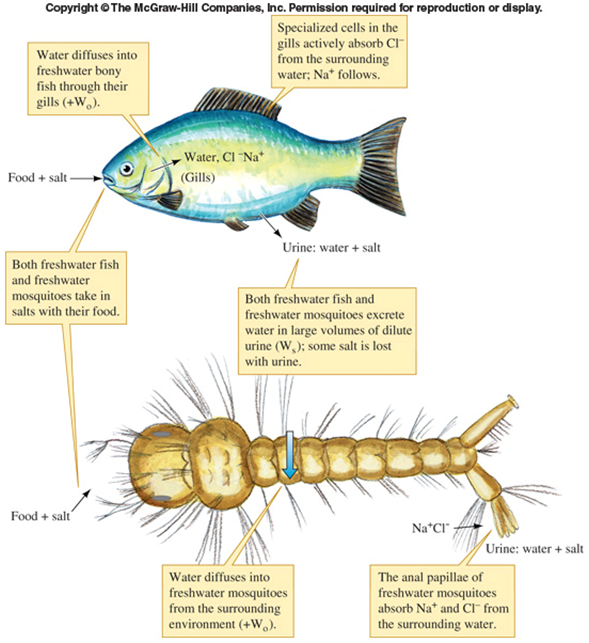In other words WARMER air can hold MORE WATER
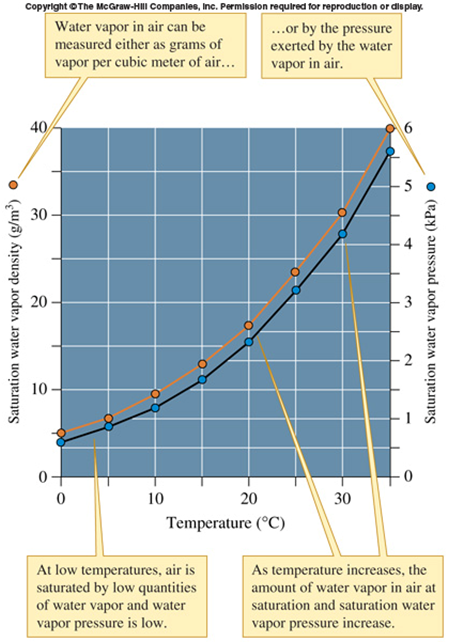
Chapter 6 -- Water Relations
In other words
WARMER air can hold
MORE WATER

The atmosphere exerts a pressure (due to gravity) on everything. Atmospheric pressure is due to all of the partial pressures of its components -- nitrogen, oxygen, water, etc. Each component exerts its own pressure. That means when talking about the water content of the air, as content (quantity) of water goes up, so does the pressure. There is a certain maximum amount of water that the air can hold. At low temperatures, the air can hold less water than at warm temperatures, which means vapor pressure is low at low temps and high at higher temps. Humidity is a measure, therefore, of the content/vapor pressure of water in the air. At saturation, the air is said to have 100% relative humidity. Why relative? Because it is relative to the temperature, as just indicated. 100% humidity at low temperature is a lot less water than 100% at high temperature.
WATER POTENTIAL GRADIENT -- plants

Because water moves from an area of higher vapor pressure to lower vapor pressure, it has the potential to move (and evaporate into the air). Plants use this water potential gradient (typically higher in the soil and lower in the air, though not always when the air has high humidity) to get water (and dissolved minerals) from the soil, because it follows the gradient from the soil, up the stem, out into the leaves and then out through the stomates into the air. It is the pull from the air above that actually is responsible for moving water (and dissolved minerals) up the plant. What this also means is that SOME water loss from the stomates is absolutely essential for normal functioning of the plant.
Water GAIN must equal Water LOSS
Losses?
Gains? for
Plants? Animals?
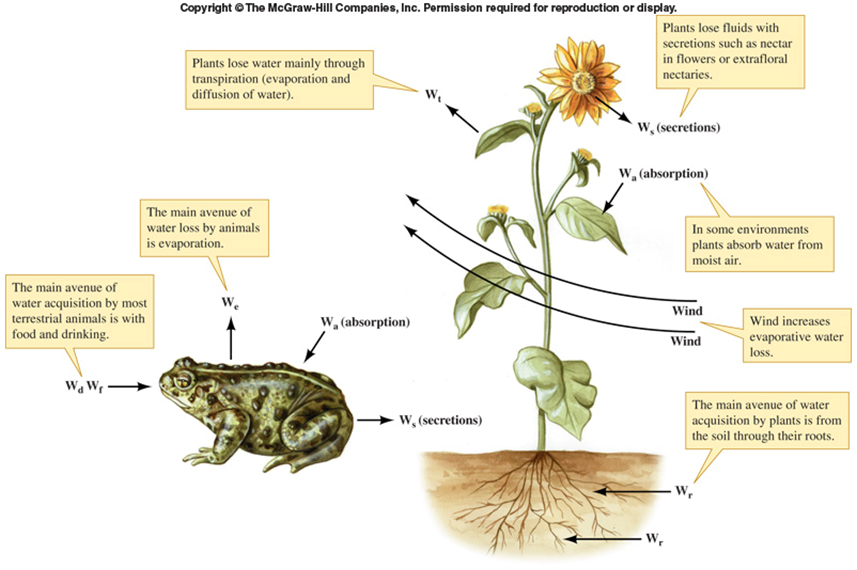
As with heat, water loss must typically be balanced by water gains. For animals, the main water loss is by evaporation, and through release of wastes (urine and feces), although water loss through waste can be remarkably minimized in some. The main gains are through food and drinking, and at least some water is MADE through metabolic processes (remember that one of the products of cellular respiration is water). For a plant, the main water loss is, as discussed above, through transpiration (evaporation out of the stomates), and to a much lesser extent evaporation from elsewhere (nectar, etc.). The main gain, also as discussed above, is through the roots.
SPECIAL ADAPTATIONS:
Animals
Namib Desert Darkling Beetle

Special adaptations for water gain in the Namib Desert Darkling Beetle. This beetle lives in an environment with very little rainfall (a desert). But early morning fogs (air with LOTS of moisture) blow across the dunes. The beetles stand with abdomens pointed toward the sky. Water condenses on the surface (elytra) of the beetle, and the water follows grooves in the surface downward toward the mouth, where the beetle then drinks the water.
Tiger beetles
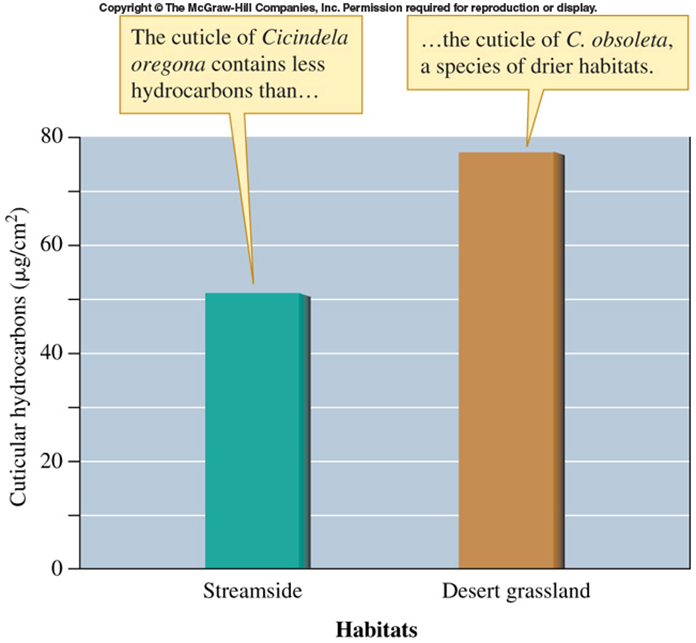
Special adaptations for preventing water loss. Tiger beetles in drier habitats have higher hydrocarbon content in their exoskeletons. Hydrocarbons are hydrophobic, and prevent water from leaving the body. So, more hydrocarbons in a dry environment, less water loss.
Plants:
Sagebrush:

Sagebrush grows a deeper, more branching set of roots on dry sites than wet sites.
Ocotillo:

Ocotillo, a desert plant, leafs out and blooms during the brief spring and fall monsoon rains; during the dry parts of the year, the plant drops all leaves and looks completely dead (picture below).

Organisms with
Similar approaches:
Saguaro and Camels -- both of these acquire lots and lots of water during the
brief times it is available, in order to make it through the dry times.
Different approaches:
Scorpions:

Scorpions hide in burrows during the daytime, in order to conserve water during the hot daytime temperatures. Like many desert animals, they restrict their activity to nighttime.
Cicadas:
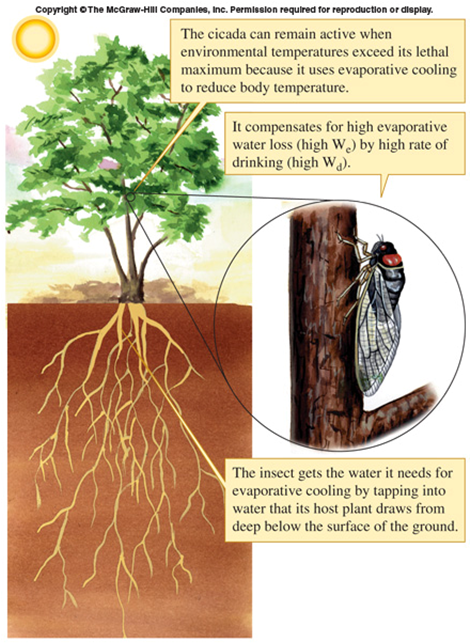

There is one Cicada species, a specialist on the desert plant Mesquite, that is actually active and calling during the very hot daytime temperatures. If it's body temperature reached the actual air temperature on some of the hottest days, it would be fatal. However, it has small pores in it's exoskeleton through which it evaporatively cools itself. How can it afford to lose water during the day? Because it has a beak that can tap into the water in the xylem of the Mesquite. Why be active during the day at all? Because if you CAN do it, you can avoid most of the predators, which, as indicated previously, are active only at night.
Water/Salt Balance in Aquatic Environments:
Marine
Environments:
Osmoconformers
Osmoregulators:
Sharks

Bony Fish / Mosquitos

Fresh Water
Environments:
Osmoregulators (only):
Bony Fish / Mosquitos
